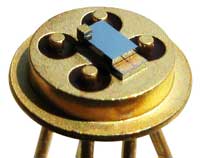
| Home | About Us | Contribute | Bookstore | Advertising | Subscribe for Free NOW! |
| News Archive | Features | Events | Recruitment | Directory |
| FREE subscription |
| Subscribe for free to receive each issue of Semiconductor Today magazine and weekly news brief. |
News
21 July 2009
Micropelt unveils 90%-efficient micro thermoelectric coolers
 Micropelt GmbH of Freiburg, Germany, a 2006 spin-off from collaborative research between Infineon Technologies and Fraunhofer Institute IPM Freiburg that manufactures thin-film thermoelectric elements, has made available samples of the MPC-D40x series, a new generation of highly efficient thermoelectric coolers (TECs).
Micropelt GmbH of Freiburg, Germany, a 2006 spin-off from collaborative research between Infineon Technologies and Fraunhofer Institute IPM Freiburg that manufactures thin-film thermoelectric elements, has made available samples of the MPC-D40x series, a new generation of highly efficient thermoelectric coolers (TECs).
Micropelt’s proprietary scalable MEMS (micro-electro-mechanical systems) micro-structuring platform technology yields TECs with an electrical resistance of more than 30 Ohms on a single square millimeter footprint which, in combination with its controller system, can be driven at an efficiency of 90% and better. The firm says that this new approach can impact the system architecture of applications using small TECs, including those where cooling is omitted for reasons of system cost and power dissipation. Applications include cooling of lower-power laser diodes and other active or passive devices in the telecoms, photonics, optoelectronics, and sensors markets.
The MPC-D403/404 TECs are fabricated using semiconductor manufacturing processes that yield what are claimed to be the world’s smallest micro-coolers. Feature sizes of 45 microns can accommodate 50 thermocouples per square millimeter (about ten times more than bulk Peltier technology can offer). “Our micro-structuring technology is able to scale to application-specific dimensions, electrical requirements, and thermal properties,” explains chief technology officer Joachim Nurnus. “We measure drive currents 10 times smaller than those known for similar bulk TECs whose few thermocouples create an electrical resistance much below 1 Ohm and hence a drive current well above 1 ampere.”
The MPC-D40x series can pump over 600mW with a drive current of 200mA, as required for thermal management of low-power edge-emitting lasers or vertical-cavity surface-emitting lasers (VCSELs). At low drive currents the power efficiency of the TEC increases. At the same time, the design of the control circuitry can be simpler, which also translates to reductions in the bill-of-materials and circuit-board footprint.
“Everyone wants their transceiver modules to be smaller and more energy efficient,” says Wladimir Punt, VP sales & marketing (who was recruited in June, and has previously worked at NXP, Microtune Holland, and Micronas). “We analyzed the thermoelectric system architecture and concluded that for very small TECs the drive current is key to solving the prevailing power consumption and heat dissipation issues,” he adds. “Cutting the drive current by 90% can improve the overall cooling system efficiency by 50%, because the drive voltage remains at a level where buck regulators can provide good efficiencies. This will help photonic packaging and system designers to develop components consuming less energy, producing less heat, and fitting into smaller packages.”
Micropelt says that its wafer-based production technology brings economies-of-scale to the high-volume manufacture of TECs. The TEC control system not only benefits from standard, inexpensive, readily available, and ultra-small TEC control circuit components, but its overall power efficiency results in greatly reduced power consumption and heat dissipation on densely packed line cards, it is claimed. Micropelt’s micro-cooler suits use with products not normally exposed to active cooling, but that would benefit from higher performance, tighter specifications, and further miniaturization.
The firm says that standard products from its pilot-production plant are being evaluated by and incorporated into the products of more than 40 customers. A large-scale production facility currently under construction in Halle, Sachsen-Anhalt, Germany will raise capacity to 10 million devices per year by mid-2010.
Volume pricing of the MPC-D403/404 TECs is targeted at $3 in quantities of 500,000 units.
![]() Search: Thermoelectric coolers
Search: Thermoelectric coolers
Visit: www.micropelt.com